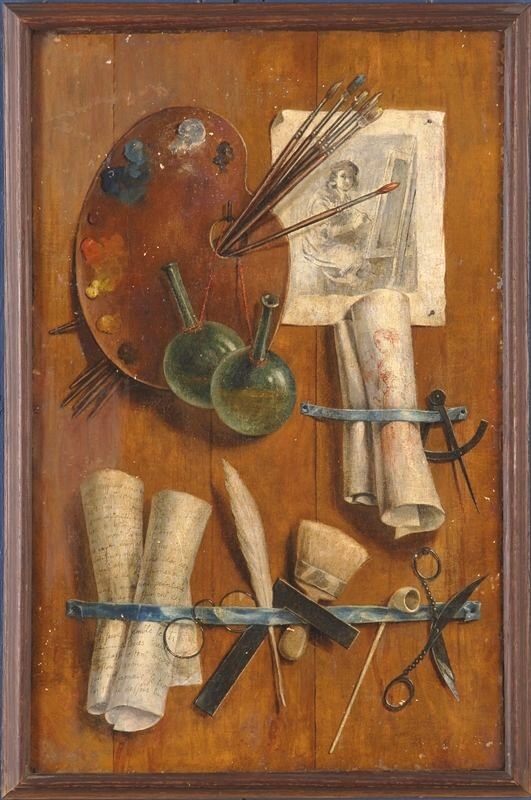
Trompe L'oeil of a Painter's Accoutrements
Anonymous French Artist
Mid-Late 19th Century
Offers
Shipping $99 Standard Parcel View Options
Questions about this piece
Item Details:
TROMPE L'OEIL OF A PAINTER'S ACCOUTREMENTS
ANONYMOUS FRENCH ARTIST
TROMPE L'OEIL, MID-LATE 19th CENTURY
Original Oil Painting on Canvas
Size: 16.0 x 20.0 in; 40.6 x 50.8 cm
Signed: unsigned
Outstanding example of one of the first exercises in Virtual Reality. Rare & important trompe l'oeil painting, successfully accomplishing a difficult-to-pull-off technical undertaking, in addition producing a further metacognitive layer of meaning as compared to most other paintings that “fool the eye”, with the (sadly) anonymous 19th century French artist creating an optical illusion by manipulating the illusory three dimensional space in the mind via only brushstrokes on a two-dimensional canvas. Additionally, the artist here paints the “tools of the trade”, making the sly comment to our astounded eyes that “not only is this just paint, but here is how I did it!”, creating further disorientation to our poor eyes and mind, trying to take it all in, and convince ourselves that what we are “seeing” is not real.
The phrase, which can also be spelled without the hyphen and ligature in English as trompe l'oeil, originates with the artist Louis-Léopold Boilly, who used it as the title of a painting he exhibited in the Paris Salon of 1800. Although the term gained currency only in the early 19th century, the illusionistic technique associated with trompe-l'œil dates much further back. It was (and is) often employed in murals. Instances from Greek and Roman times are known, for instance in Pompeii. A typical trompe l'œil mural might depict a window, door, or hallway, intended to suggest a larger room.
A version of an oft-told ancient Greek story concerns a contest between two renowned painters. Zeuxis (born around 464 BC) produced a still life painting so convincing that birds flew down to peck at the painted grapes. A rival, Parrhasius, asked Zeuxis to judge one of his paintings that was behind a pair of tattered curtains in his study. Parrhasius asked Zeuxis to pull back the curtains, but when Zeuxis tried, he could not, as the curtains were included in Parrhasius's painting—making Parrhasius the winner.
Creator: Anonymous French Artist
Creation Year: Mid-Late 19th Century
Dimensions: 16 x 20 in
Medium: Original Oil Painting on Canvas
Movement/Style: Trompe L'Oeil
Period: 1850-1899
Condition: Very Good
